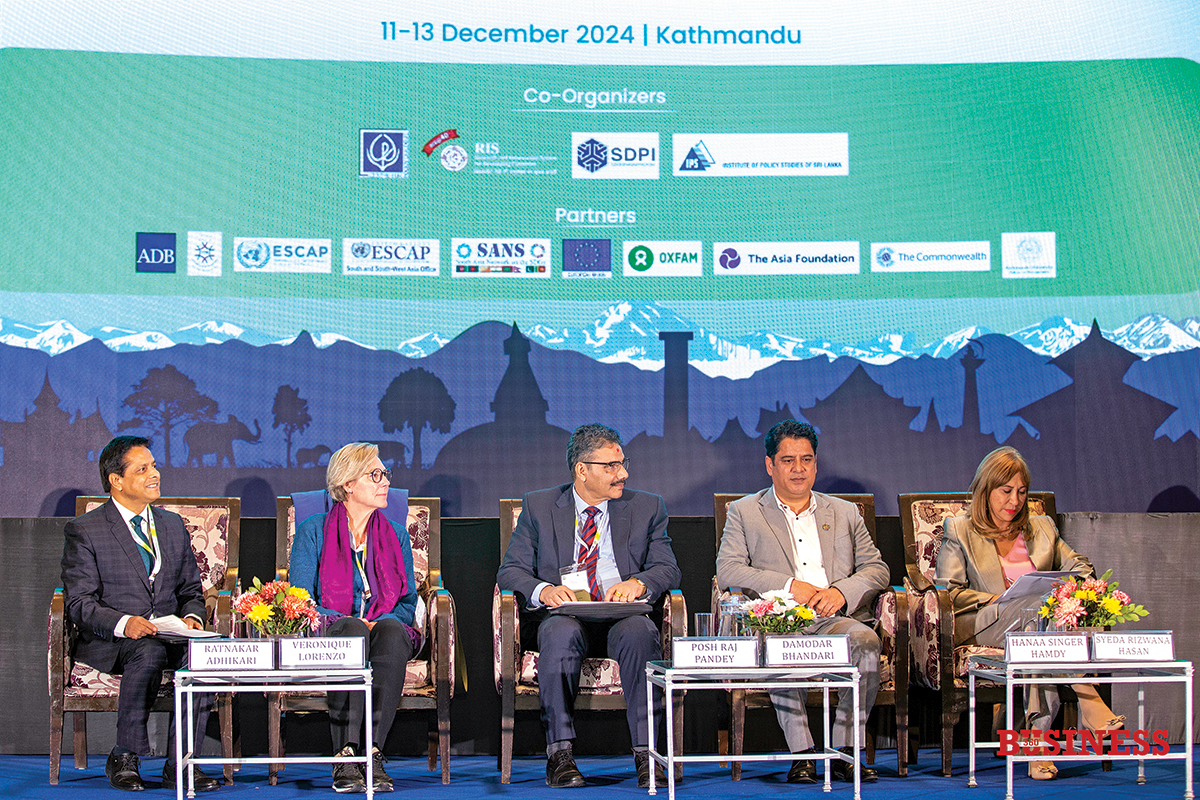
When countries collaborate and cooperate in a region, they can create larger markets, attract more investment and enhance trade. This can lead to significant economic growth and development, and benefits all member countries. While facing challenges like natural disasters, climate change and health crises, the member countries can share resources, expertise and strategies to effectively tackle these issues.
Every speaker at the 15th South Asia Economic Summit (SAES XV) recently held in Kathmandu stressed the importance of regional cooperation.
"South Asia's history is one of fractured value chains. Land, water and air were common resources, but historical processes have fractured this inheritance," said Prof Dr Rehman Sobhan, Chairman of the Centre for Policy Dialogue (CPD), Bangladesh. He stressed the need for institutional platform to bring together initiatives for developing and sustaining value chains. He also highlighted the importance of intergovernmental cooperation. "The vital contribution of SAES is to keep alive the idea of cooperation’s benefits. Reviving the SAARC process and initiating discussions with government policymakers is essential," Dr Sobhan remarked.
Dr Ratnakar Adhikari, Chairman of South Asia Watch on Trade, Economics and Environment (SAWTEE), highlighted progress in some countries, such as Bhutan's carbon-negative status, Nepal's cost-effective electric vehicle (EV) operation, and India's advancements in renewable energy. He stressed the potential of regional collaboration to enhance sustainable development.
Collective climate action was also a major focus at SAES XV. EU Ambassador to Nepal, Veronique Lorenzo, highlighted the EU's role as the largest climate finance provider and the need for global partnerships. She stressed Nepal's potential in renewable energy and the importance of disaster preparedness. She stated that green initiatives represent the new economic model and called for increased investment in it.
Bold action and ambitious thinking are necessary to harness South Asia's potential for equitable green transformation. According to Hanaa Singer-Hamdy, United Nations Resident Coordinator in Nepal, vulnerabilities can be turned into strengths, challenges into opportunities, and South Asia's climate story into one of resilience and hope. She outlined four main points: Green and Just Transition, Regional Cooperation, Technological Advancements, and Unlocking Human Potential.
Meanwhile, the Government of Nepal expressed its commitment to climate resiliency and potential of green energy to create jobs and reduce environmental footprints. Minister for Industry, Commerce and Supplies, Damodar Bhandari, highlighted Nepal's renewable energy resources, particularly hydropower.
Energy-intensive products and digital transformation also play a crucial role in shaping the South Asian region's value chains. While South Asia is not currently a major player in the green goods market, technology transfer remains essential for the region to enter these value chains. "Most of these products have high embedded intellectual property, making technology transfer central to how countries can participate," said Dr Pritam Banerjee, Head and Professor at the Centre for WTO Studies in India.
The effects of climate change on food security and the necessity of addressing transport needs were also discussed. From the discussion, it came to light that international carbon trading can encourage companies to invest in cleaner technologies and practices which can help mitigate climate change.
"The carbon border adjustment mechanism (CBAM) is a critical factor," said Dr Abid Qaiyum Suleri, Executive Director of Sustainable Development Policy Institute (SDPI), Pakistan. He elaborated that exporters with high carbon emissions will face carbon taxes if they do not comply with permissible levels and expressed concerns about the global adoption of CBAMs, including those being developed by the UK, Australia, the US and China. He called for regional certification and standardisation on green change. "We need regional certification and standards to address these challenges," he said.
Dr Rupa Chanda, Director of Trade, Investment and Innovation at the United Nations Economic and Social Commission for Asia and the Pacific (UN ESCAP), stressed the need for developing robust value chains through comprehensive strategies and policies. She highlighted the region's challenges in manufacturing competitiveness and insufficiently diversified services. "Investment policies are crucial, both domestic and foreign, to attract the right investments and facilitate technology transfer," she mentioned. "MSMEs form the bulk of value chains and need targeted approaches to drive sustainability."
Speakers at the summit talked about the importance of multilateral discussions at World Trade Organisation (WTO). Vishakha Srivastava from the Centre for WTO Studies in India said that while international cooperation is crucial, countries must also enhance their domestic capacities.
The three-day summit brought together prominent economists, policymakers and civil society leaders from South Asia to advance sustainable and inclusive development in the region. At the closing session, Nepal's private sector representative organization, Federation of Nepalese Chambers of Commerce and Industry, called for reforming regional economic integration and prioritising environmentally friendly practices in trade and investment agreements.
The SAES XV served as a platform where policy influencers came together to seek solutions and opportunities. Business 360 spoke to a few panellists regarding the importance of the issues raised during the summit.
-1738059082.jpg)
Dr Mariyam Shakeela
Former Cabinet Minister, Maldives and CEO, SIMDI Group, Maldives
The Maldives faces significant challenges due to rising sea levels, being one of the lowest-lying nations in the world. Our efforts to address this existential threat are multi-faceted, focusing on coastal protection, disaster preparedness and climate adaptation. We have built seawalls, preserved mangroves and implemented strict building codes to combat flooding. Renewable energy initiatives and sustainable tourism practices are at the heart of our approach to reducing greenhouse gas emissions and safeguarding natural resources. We also actively participate in international agreements and conventions on climate change, advocating for increased climate finance and equity in global decision-making.
Our collaboration with Nepal and other nations highlights shared challenges despite geographic differences. While Nepal is mountainous and landlocked, and the Maldives is an island nation, both countries are vulnerable to the impacts of climate change caused by global emissions. Together, we advocate for increased funding, better access to resources like the Green Climate Fund, and capacity-building to address these challenges effectively. NGOs, community organisations, and businesses from both nations collaborate on adaptation projects and public awareness campaigns. Women, often disproportionately affected by climate change, must be prioritised in funding and policy discussions.
The Maldives offers valuable lessons in sustainable economic growth and environmental stewardship, particularly in the tourism sector. We have made tourism a green industry, focusing on preserving marine ecosystems and involving local communities in sustainability efforts. Our tourism management emphasises long-term environmental care, public awareness and training, ensuring economic stability while protecting natural resources. Nepal can draw inspiration from these strategies to enhance its own tourism industry and build resilience against environmental challenges.
There is also significant potential for collaboration in tourism between Nepal and the Maldives. By combining Nepal’s majestic mountains and hill resorts with the Maldives’ turquoise waters and luxurious resorts, we can create unique travel experiences. Collaborative marketing, joint travel packages and regional tourism promotions could benefit both countries, enhancing economic opportunities and fostering stronger bilateral ties. Together, we can create a vision of sustainable tourism that respects and preserves the beauty of our respective nations while providing unforgettable experiences for travelers.
-1738059080.jpg)
Dr Brendan Vickers
Adviser & Head of International Trade Policy, Commonwealth Secretariat, London, UK
The trade relationship between Commonwealth countries and South Asia, particularly Nepal, presents a landscape of opportunities and challenges. South Asia is a dynamic region with fast-growing economies, and Commonwealth networks offer mechanisms that can enhance trade. However, as a landlocked country with a narrow export base, Nepal faces hurdles in expanding its trade. Its exports, such as knotted carpets, synthetic fibres and fruit juices, largely target India, Bangladesh, the UK and Canada. Meanwhile, India remains the major supplier for Nepal’s imports, including petroleum products, machinery and medicines.
Though Nepal is not a Commonwealth member, it benefits indirectly from initiatives like the Commonwealth’s advocacy for Least Developed Countries (LDCs) and Aid for Trade programmes. These efforts help countries like Nepal address trade challenges, such as high transaction costs and regulatory barriers. Enhancing digital trade, simplifying customs procedures and reducing non-tariff barriers could further unlock Nepal’s trade potential, particularly in the Commonwealth markets.
Nepal’s upcoming graduation from LDC status in 2026 is a milestone reflecting progress in education, healthcare and economic resilience. However, it comes with challenges. Losing preferential trade benefits, such as duty-free access to markets like the EU, UK and USA, will impact Nepal’s exports. Studies suggest Nepal could lose $60 million, equivalent to over 4% of projected exports in 2026. Stricter rules of origin and increased obligations under WTO agreements will add institutional and financial pressure.
To mitigate these impacts, Nepal must leverage its transition period effectively. The government has developed a Sustainable Transition Strategy, focusing on economic transformation, trade and investment, climate resilience, and social inclusion. Strengthening sectors like ecotourism and digital trade is crucial. Nepal’s youthful demographic is a significant asset, and investments in education, vocational training, and job creation can unlock its potential, especially in technology-enabled services.
Nepal’s bilateral trade agreements with India and China provide a foundation for resilience. Duty-free access to Indian markets and tariff concessions from China can help maintain trade momentum, though logistical challenges remain. Enhancing transit and trade facilitation measures will be critical for post-graduation success.
Clean and green energy is another area where Nepal holds immense potential. With an estimated hydropower capacity of 83,000 MW, Nepal can become a significant exporter of renewable energy in South Asia. Collaboration with the UK and other Commonwealth nations could drive investment, technology exchange and job creation in the clean energy sector. Exporting surplus energy and exploring carbon credits could further bolster Nepal’s economy while contributing to global sustainability goals.
In conclusion, Nepal’s path forward requires strategic efforts to capitalise on opportunities in trade, energy and digital transformation. Partnerships with Commonwealth countries can play a vital role in fostering economic growth, supporting a smooth LDC graduation, and building a resilient future.
-1738059080.jpg)
Dr Debapriya Bhattacharya
Distinguished Fellow, Centre for Policy Dialogue, Bangladesh
Convenor, Citizen's Platform for SDGs, Bangladesh
Since August 5, when Bangladesh experienced a shift in government following widespread public and student uprisings, the country’s economic situation has been under intense scrutiny. The previous administration's 15-year-long growth narrative has come into question, as it appears many of its economic figures, particularly GDP growth rates, were inflated. The new interim government has prioritised transparency and reform to address the issues inherited from the past.
To achieve this, a white paper committee was established to assess the economic state of the country. This comprehensive report, involving experts from various fields, revealed significant shortcomings. It exposed a politically driven data system, with inflated growth figures affecting GDP, tax and debt ratios. Moreover, widespread misuse of public resources was uncovered, particularly in the banking, energy, public construction and ICT sectors. Non-performing loans and questionable projects drained resources, while large sums were misspent on outdated technology. These findings highlight the urgent need for systemic reforms to ensure sustainable development.
The challenges are daunting, particularly as Bangladesh prepares to graduate from its Least Developed Country (LDC) status. This transition demands macroeconomic stabilisation, reforms in key sectors like banking and energy, and strategies to support exports and remittances. Despite the hurdles, Bangladesh meets the critical LDC graduation criteria, unlike Nepal, which faces greater economic vulnerabilities. Both nations must prepare for a post-graduation period where benefits like duty-free market access will no longer apply. Collaboration and shared lessons between Nepal and Bangladesh, especially in areas like migration cost reduction, are crucial.
Energy trade is a promising avenue for cooperation. Bangladesh has already begun importing electricity from Nepal via India and aims to expand this partnership. Projects like the Matarbari Deep Sea Port, developed with Japanese support, are set to enhance regional connectivity, benefiting Nepal and India's northeastern states. These initiatives underscore the potential for stronger ties and mutual growth.
Politically, Bangladesh is navigating its transition to democracy. The peaceful establishment of a civilian government in August, despite potential military intervention, reflects a commitment to democratic principles. However, the country must address the systemic issues that allowed cronyism and corruption to flourish under the guise of democracy. Insights from leaders like Professor Muhammad Yunus, advocating for zero emissions, unemployment and inequality, provide a vision for sustainable progress.
Bangladesh also faces challenges in its relationship with India, complicated by the previous regime’s ties and concerns over minority rights. However, recent diplomatic engagements suggest a potential reset in bilateral relations. Amidst these complexities, Bangladesh’s focus remains on reform, collaboration and a more inclusive approach to development, both domestically and regionally.
-1738059082.jpg)
Ieva Baršauskaitė
Lead, Trade and the Green Transition, International Institute for Sustainable Development, Switzerland
Nepal is uniquely positioned to leverage trade policies to support industrial decarbonisation and embrace sustainability. With one of the world’s cleanest electricity grids, powered by hydropower, Nepal has a competitive edge in the global race toward Net Zero. Exporters can capitalise on the growing demand for sustainably produced goods, especially in major developed markets where sustainability is increasingly a criterion for access. However, producing sustainably is not enough; Nepal must also build the capacity to track carbon emissions and prepare sustainability certifications for its exports, particularly in agriculture and heavy industries. Collaboration with trading partners and investment in technical assistance will be crucial for meeting the evolving demands of global value chains.
Nepal’s trade policies should prioritise identifying its niche in global markets while encouraging green economic transformation. Smaller nations must strike a balance between incentivising sustainable production and maintaining competitiveness. Trade agreements, like Switzerland’s innovative deals, offer valuable lessons. For instance, Switzerland's agreement with Indonesia uses private certification to ensure sustainable palm oil exports. Nepal could explore similar provisions to promote its green exports. Additionally, agreements like the ACCTS demonstrate how smaller countries can lead by integrating environmental goods and services into trade while reforming fossil fuel subsidies. These examples highlight the potential for Nepal to align its policies with progressive global trends.
Environmental challenges like plastic pollution and deforestation can also be addressed through trade policies. Sustainability standards, such as the EU's deforestation-free regulations, create opportunities for Nepali exports like coffee, though compliance remains a challenge. Engaging with international partners to clarify requirements and prepare exporters will be critical. Plastic pollution, even on iconic sites like Mount Everest, underscores the need for Nepal to participate in global initiatives like the Plastics Treaty. Trade measures, including bans on single-use plastics and commitments to recycling and circularity, can serve as blueprints for Nepal’s approach to managing plastic waste sustainably.
Nepal can draw inspiration from countries that have successfully integrated sustainability into trade policies. Costa Rica, a leader in green development and ecotourism, demonstrates how prioritising sustainability can bolster trade. Rwanda’s efforts in tackling plastic pollution and promoting sustainable agriculture offer valuable lessons, particularly for exports like coffee. Morocco’s investment in renewable energy, turning it into a green energy exporter, highlights Nepal’s untapped potential in hydropower exports.
Successful international cooperation is vital for Nepal’s green transition. Regional collaboration can address logistical challenges, integrate Nepal’s exports into regional value chains, and attract investments in green technologies. Joint projects with neighbouring countries have higher potential to secure climate finance, which is becoming increasingly competitive. Additionally, technical assistance, capacity-building programmes, and technology transfer will play significant roles in ensuring Nepal’s sustainability goals are met. By working with the global community, Nepal can effectively navigate its unique challenges and position itself as a leader in sustainable development and trade.
READ ALSO:






